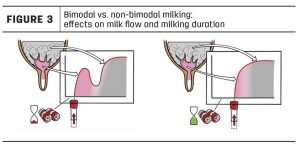
This is the life that Kelly and Christy Cunningham, who are partners in Milk Unlimited near Atlantic, Iowa, have grown accustomed to. Their team of approximately 35 people milks 300 cows an hour and operates 24 hours a day. Every day, more than 30,000 gallons of milk leaves their farm. Although in 2017, that nearly came to a halt.
HISTORY
Milk Unlimited was established 24 years ago. The Atlantic location was attractive because of a close proximity to Omaha, a good milk market, good schools and relatively cheap feed. They began by purchasing 1,800 Holstein cows and shipped to a private fluid milk bottler.

Milk production hovered between 65-70 lbs. and components between 3.2 – 3.5% fat and 2.65-2.85% protein. The Cunninghams share that their herd cull rate was too high, ranging between 40-45%.
“Our reproduction was great during the winter and poor during the summer,” Kelly says.
Improved management practices boosted their production, but the Cunninghams say that component and culling rates remained unchanged and that their veterinary costs were too high.
“Our vet and medicine cost averaged between $20,000 to $25,000 a month,” Kelly says. “And we were heavy user of hormones for reproduction.”
The scenario spelled a financial rollercoaster for Milk Unlimited. Christy shares that they were working too hard for the results and their cost of production was simply too high.
“The cows milked well, but they didn’t last,” she says.
A near crash in their rollercoaster ride occurred in 2017 when Milk Unlimited’s processor ended their contract agreement.
“We were forced to make management changes to secure a new market for our milk,” Kelly says.
NEW DIRECTION
With no other fluid milk market around, the Cunninghams were thankful that they found a cheese market to ship their milk to. However, going from fluid milk to a cheese market made the couple look at their breeding philosophy differently.
“The crossbreeding trend seemed to work for other dairies,” Kelly says.
Switching to Jerseys wasn’t really an option for the Cunninghams. They didn’t want to invest the capital to change their dairy’s set-up to accommodate smaller-framed cattle.

“A good friend of mine, Todd Tuls, a fellow dairy producer, talked to us about ProCROSS cattle, Kelly says. “Although, it was a big step to put Monte and Red semen into nearly 20 years of Holstein breeding.”
When considering this breeding change, the Cunninghams knew they needed to:
- Increase components for a cheese market.
- Improve longevity in the herd.
- Develop fewer heifers.
- Maintain moderate size cows.
- Improve profitability.
Purchasing cows from three different herds in California, Idaho and Michigan, in April 2018, Milk Unlimited began milking their first ProCROSS cows. Additionally, they bred their Holstein cows to Montbeliarde.
Christy says that dairying is no longer just a way of life, it’s a business. Kelly echoes the sentiments and while it took a lot of deep conversations and time thinking about changing how they do business, ultimately it came down to dollars and sense.
LOOKING AT DATA
The Cunninghams are extremely happy with how it all has worked out. In addition to securing a new milk market and improved components and reproduction, they also share their bottom line is better off milking ProCROSS cows compared to their Holsteins.
“Our hauling costs is 5.8% lower. This is huge as hauling is the fourth largest cost on our farm,” Kelly reports. “We now can put a 100 lbs. of milk in a 94.2-pound container.”
The Cunninghams say it’s all in the data and document the herd averages between their Holsteins and ProCROSS cows. Their ProCROSS cows averaged 78.6 lbs., 93.3 lbs., and 98.8 lbs. in their first, second and third lactations. While their Holstein cows averaged 78.8 lbs., 89.2 lbs., and 95.9 lbs., respectively. Additionally, dry matter intake is 5.0% less with their ProCROSS cows compared to their Holstein herd, with no individual sampling performed.
When looking at reproduction data, Kelly shares that his Holstein cows averaged 122.3 days open compared to his ProCROSS cows, who averaged 96.3 days, and this is accomplished with less use of hormones.

“We don’t start Ovsynch until 100 days in milk with the ProCROSS cows,” Kelly states. “While we started Ovysnch at 50 DIM with the Holsteins.”
Culling rates also decreased with the ProCROSS cows, which Kelly says is the most important herd reproduction number.
“The ProCROSS cows represented 87.4% pregnant cows, while my Holsteins are at 81.8%,” he says. “That means we have 5.7% more ProCROSS cows pregnant compared to our Holsteins.”
Health data followed suit, with Milk Unlimited’s ProCROSS cows having fewer sick cows compared to their Holsteins. For example, their ProCROSS cows had:
- 72% fewer ketosis incidences
- 65% fewer displaced abomasums
- 81% fewer milk fever
- 61% fewer mastitis cases
- 30% fewer pneumonia
- 40% fewer cow touches
Holsteins favored better in:
- Metritis was 29% higher with ProCROSS
Looking back, the Cunninghams are thankful that Tuls encouraged them to consider ProCROSS genetics. It not only saved their dairy by producing more nutrient-dense milk which made sense to their ‘new’ cheese milk market. But, also, in the end, it generated a healthier and more profitable herd at their Western Iowa dairy.

“We have an overall healthier herd,” Kelly says. “Better health, better reproduction, better components and overall are more profitable. What more could I have asked for?”

























